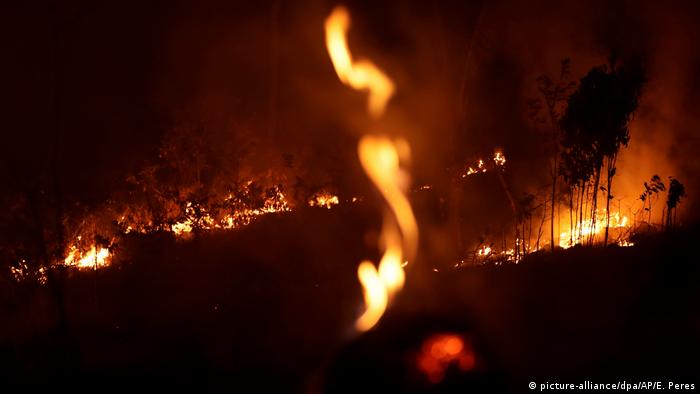Fires are not only devastating. For some Ecosystems, they are even for their preservation is important. And some plants and animals can only survive with fire and heat.

In a rain forest like the Amazon, massive forest fires are a disaster. You destroy the habitat of tens of thousands of plant and animal species permanently. The rain forest burns down, you lose all the nutrients, because they are stored in the rainforest in the plants themselves, not in the ground.
In spite of the lush Vegetation and unique species diversity, the soil is particularly barren and low in nutrients. Fallen leaves or Branches are broken down thanks to the year-round moist and warm climate immediately of fungi and bacteria, and the released nutrients are again absorbed by the roots and not the ground. The thin layer of humus is washed out after a forest fire quickly, and no later than three years after the fire, it does not grow in the leached soil.

Nutrients are stored in the rain forest only in the plants themselves, not in the barren soil.
Tropical rain forests like in the Amazon, but also in the Congo basin or in Southeast Asia, refer to scientists as “fire-sensitive Ecosystems”. Around a third of the Ecosystems are regarded worldwide as “fire sensitive”. Serious fires have occurred there in the past, due to the natural moisture of the Vegetation and structure rare.
In the case of a prolonged drought provoked by the climatic phenomenon El Niño, or in the case of deliberate arsons – for example, for the large-scale logging and conversion into plantations, occur there, but fast catastrophic wildfires. Because the plants and animals there is a natural resistance, and recovery ability in case of fire is missing.
Cleansing power of fire
So devastating forest fires in the rainforest are also, required is the destructive power of fire for the conservation of other Ecosystems. There has developed the natural Fauna and Flora is partly due to the fires.

Destructive renewal: Only by fire as a habitat for new plants
Only regular fires have given to these Ecosystems, with their distinctive structure. The concerns about three-quarters of all habitats in the world, above all, the Siberian Taiga, the African savannas, the South Asian monsoon and dry forests, the California forests, the Australian eucalyptus forests, as well as the Mediterranean region.
In these fire-dependent Ecosystems, animals and plants often have natural resistance, and recovery ability.
The type of fires, however, is different. In grasslands, savannahs, in particular forests and wetlands, only a moderately intense ground fire by sweeping master, which ensures that the open landscape structure is maintained.
In Busch landscapes or forests, however, is rather rare, but very intense fires are a characteristic feature, the old and sick trees eliminate, new habitat creation and for ecological rejuvenation of the tree stock to ensure.
The person engages in these Ecosystems, it prevents such as for the protection of the population of these smaller fires, this can have fatal consequences. Because more and more fuel is accumulated with the time-resistant Material. Also, less severe fires can develop very quickly to extremely destructive fire rolls. This happens, among others, in Australia or in the dense pine forests in the southwest of the United States, which were once grasslands.

The burned pine forests of California were formerly often grass landscapes
But also in fire-dependent Ecosystems of human intervention and sometimes, when fires occur too frequently, such as currently for instance in the Siberian Taiga. Due to the population growth and the exploitation of new areas of fires breaking out there more and more frequently, the large forest areas are destroyed and huge quantities of stored carbon dioxide are set free.
New life thanks to the fire
Many plants in the South of the USA, in the Mediterranean or in Australia stock even need the fire for her to continue. The North American fir species, Douglas-fir about withstand due to their thick bark, most of the fires and drives then fresh. Also, the North American Lodge pole pine felt only in the case of an ordinary forest fire, the impulse to open their cones and their seeds release, the Australian grass tree requires the flue gases from the air to its seed capsules open.
Without the otherwise dense tree canopy, more sunlight falls after a fire, light to the forest floor and the seedlings sufficient nutrients, because you do not have to compete with other plant species.Even some species of insects, the fire need to Survive. The larvae of the Australian fire beetle, for example, can only develop in freshly burnt wood. Thanks to its heat-sensitive Sensors of the fire can track the beetle fires up to 50 miles away.
The descendants of the European-based pine splendor beetle feed preferably from burnt wood. Other through the smoke, stunned beetles and insects are, in turn, for storks and birds of prey after a forest fire is a godsend.

In the Mediterranean, the forest fire season will begin earlier and earlier and always take longer
Accelerant Of Climate Change
As a result of climate change will exacerbate the risk of forest fire more. In the southern Mediterranean, for instance, will exist in a few decades all the year round risk of forest fires. Also in the North of Italy and the Iberian Peninsula, the choice of fire season will begin earlier and earlier and longer-lasting. At the same time, the frequency of Flashing increases, again resulting in more frequent forest fires will be created.
Due to forest fires, 15 percent of global greenhouse gas emissions, more than 30 percent of global carbon monoxide emissions, ten percent of the methane emissions, emissions and more than 85 percent of the world’s soot.
Forest fires contribute massively to climate warming, which in turn leads to dehydration and weakening of the forests. New fire there, through this destructive cycle is often an easy game.